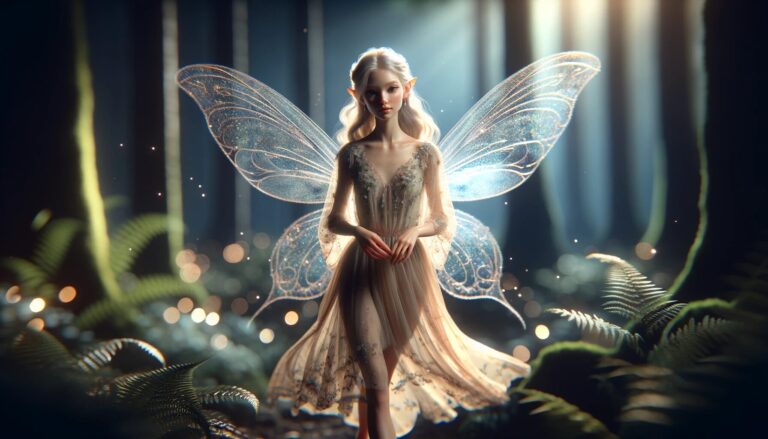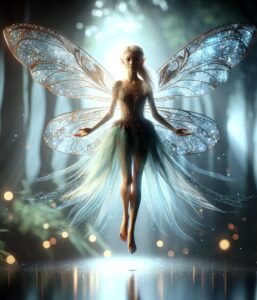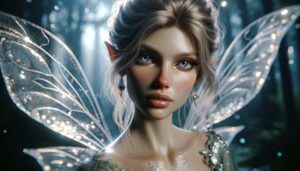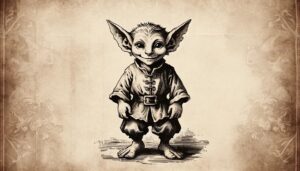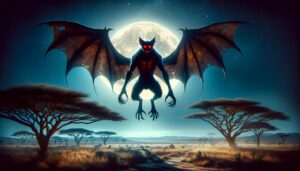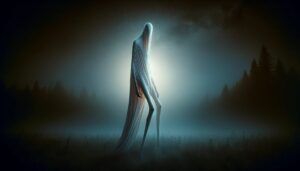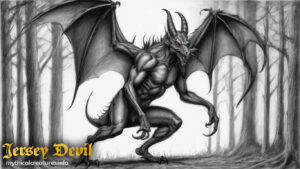Table of Contents
In mythology, Fae refers to the collective category of beings known as fairies or faeries. Fairies are mythical and supernatural creatures found in the folklore of various cultures, particularly in European traditions. These beings are often depicted as small, magical entities with human-like appearances but possessing otherworldly powers and attributes.
Fairies are associated with the natural world, often living in forests, meadows, or other natural settings. They can be benevolent or mischievous, depending on the specific folklore or story. In many tales, they are believed to have the ability to influence human affairs, grant wishes, or interact with humans in various ways.
Fairies are a part of European folklore and mythology and have been influenced by various historical and cultural factors. Some scholars believe that the belief in fairies may have been influenced by earlier pagan beliefs and nature spirits in Europe. As Christianity spread across Europe, these pagan beliefs merged with Christian ideas, leading to the development of fairy folklore. The term “fairy” itself comes from the Latin word “fata,” meaning fate or destiny, and evolved into the Old French word “faerie,” which referred to enchantment or magic. Over time, it became associated with the supernatural beings we now call fairies.
Fairies and similar supernatural creatures appear in the folklore of many European countries, including Ireland, Scotland, England, and Wales. They were often seen as intermediaries between the human and spirit worlds, capable of both helping and harming humans.
The specific characteristics and attributes of fairies can vary widely between different cultures and regions, and their origins are complex and multifaceted. As a result, the concept of fairies in folklore is rich and diverse, shaped by centuries of cultural evolution and storytelling traditions.
Physical Description
The physical description of fairies, or “fae,” can vary widely depending on the specific folklore or story in which they appear. However, there are some common traits and characteristics often associated with fairies in European folklore:
Size: Fairies are often portrayed as small, diminutive beings, sometimes only a few inches tall. This characteristic sets them apart from humans.
Humanoid Appearance: Fairies typically have a humanoid appearance, resembling tiny people with human-like features. They may have wings, but not all fairy folklore includes wings.
Wings: In some depictions, fairies are described as having wings like those of insects or birds. These wings are often transparent or iridescent.
Clothing: Fairies are often depicted wearing clothing made from natural materials like leaves, flowers, or other plant materials. Their attire is usually described as ethereal and beautiful.
Agelessness: Fairies are often portrayed as ageless or immortal beings, appearing perpetually youthful regardless of their actual age.
Otherworldly Beauty: Fairies are often described as incredibly beautiful or enchanting, with an otherworldly allure that can captivate humans.
Magical Auras: Fairies are associated with magic and are believed to emit a magical aura or glow. Their presence is said to be accompanied by a sense of wonder and enchantment.
Shapeshifting: Some fairy folklore suggests that fairies have the ability to change their appearance or size, allowing them to take on various forms.
The personalities of fairies, or “fae,” in folklore and mythology can vary widely depending on the specific tradition, culture, and story. Fairies are often depicted as diverse beings with a range of personalities, and their traits can include:
Mischievousness: Many fairies are known for their mischievous and playful nature. They may engage in pranks, tricks, and whimsical activities, sometimes causing trouble for humans.
Benevolence: Some fairies are portrayed as kind and benevolent beings who offer assistance and protection to humans, especially if they are treated with respect and kindness.
Capriciousness: Fairies are often seen as unpredictable and capricious in their actions. They may switch from being helpful to causing harm, depending on their mood or how they are treated.
Curiosity: Fairies are sometimes depicted as curious creatures who take an interest in the human world and are eager to explore and learn about it.
Guardianship: Certain types of fairies are seen as guardians of nature, animals, or specific places. They may take on a protective role, particularly when it comes to protecting the natural environment.
Tricksters: Fairies can be skilled tricksters who use their cunning and magical abilities to outwit humans or other supernatural beings.
Enchantment: Fairies are often associated with enchantment and the ability to cast spells or create magical illusions. Their actions may be influenced by their magical abilities.
Loyalty: In some stories, fairies are loyal to their own kind and may form close-knit communities or families, with a strong sense of camaraderie.
Different types of fairies within various traditions may have distinct personalities, and the perception of fairies in literature and popular culture can also influence their characterization. As such, there is no single, universally agreed-upon personality for fairies; they are a diverse and multifaceted category of mythical beings.
Special Abilities
Fairies, or “fae,” in folklore and mythology, are often attributed with a wide range of special abilities and magical powers. These abilities can vary depending on the specific folklore or story, but here are some common special abilities associated with fairies:
Flight: Many fairies are depicted as having the ability to fly, often aided by wings that resemble those of insects or birds.
Magic: Fairies are renowned for their magical abilities. They can cast spells, create enchantments, and use their magic for various purposes, such as granting wishes, causing transformations, or manipulating the natural world.
Shape-Shifting: Some fairies have the power to change their appearance or take on different forms. This ability allows them to interact with humans or other creatures while concealing their true identities.
Invisibility: Fairies are often described as being invisible to humans unless they choose to reveal themselves. This invisibility allows them to observe and interact with the human world without being seen.
Glamour: Fairies are known for their ability to cast a glamour or illusion that can make themselves or objects appear differently from their true nature.
Teleportation: Fairies are sometimes believed to have the power to teleport or move instantly from one location to another.
Time Manipulation: In some folklore, fairies are associated with time manipulation, and they may have the ability to control time or age.
Healing: Certain fairies possess the power to heal injuries or illnesses, and they may use their magical abilities to help humans in need.
Nature Manipulation: Fairies often have a strong connection to nature and can influence the weather, plants, and animals. They may be responsible for seasonal changes or the growth of plants and flowers.
Communication with Animals: Some fairies can communicate with animals and have a deep understanding of the natural world.
Control over Dreams: Fairies are sometimes believed to have the ability to enter and influence the dreams of humans, either to impart messages or to offer guidance.
Immortality: Many fairies are considered immortal or long-lived, maintaining their youth and vitality throughout the ages.
In modern usage and symbolism, fae’s, have taken on various meanings and interpretations, often departing from their traditional folklore roots. Some ways in which fairies are understood and symbolized in contemporary culture:
Fantasy Literature and Pop Culture: Fairies continue to be popular figures in fantasy literature, novels, and modern storytelling. They often appear as central characters in books, movies, and TV shows that cater to both children and adults. Examples include Tinker Bell from Disney’s “Peter Pan” and the fairies in J.R.R. Tolkien’s “The Lord of the Rings.”
Enchantment and Magic: Fairies are associated with enchantment and magic in modern symbolism. They represent the idea of a magical world hidden just beyond the ordinary, encouraging a sense of wonder and imagination.
Childhood and Innocence: Fairies are often seen as symbols of childhood innocence and imagination. They evoke a sense of nostalgia and whimsy, reminding people of the wonder and magic of their early years.
Femininity and Empowerment: In some modern interpretations, fairies are seen as symbols of femininity and female empowerment. They are depicted as strong, independent, and capable beings who defy traditional gender roles.
Environmentalism and Nature: Fairies are sometimes used as symbols of nature conservation and environmentalism. They represent the importance of preserving the natural world and its delicate balance.
LGBTQ+ Representation: In recent years, some have interpreted fairies as symbols of LGBTQ+ identity and pride, embracing the idea of embracing one’s uniqueness and authenticity.
Personal Transformation: Fairies can symbolize personal growth and transformation. They represent the potential for change, self-discovery, and the realization of hidden talents and potential.
Art and Aesthetics: Fairies often serve as artistic and aesthetic motifs in contemporary art, fashion, and design. They are associated with beauty, grace, and the ethereal.
Ethical Duality: The duality of fairies, with both benevolent and mischievous traits, can symbolize the complexity of human nature. They serve as a reminder that people can embody both light and dark qualities.
Symbol of Hope: Fairies are sometimes seen as symbols of hope and positivity, representing the belief in better things to come, even in challenging times.
Ralated and similar creatures
There are numerous creatures and beings in mythology, folklore, and fantasy literature that are related to or share similarities with fairies (fae). These beings often have overlapping characteristics or inhabit similar realms.
Elves: Elves are mythical beings found in various mythologies and folklore. They are often associated with nature, magic, and longevity. Like fairies, elves are often depicted as beautiful, ethereal beings with a connection to the natural world.
Pixies: Pixies are small, mischievous supernatural creatures in English folklore. They are often seen as close relatives to fairies and share many characteristics, including a penchant for pranks and a connection to nature.
Brownies: Brownies are household spirits in Scottish and English folklore. They are helpful beings who perform domestic chores in exchange for offerings of food. They are similar to fairies in their interactions with humans but are less ethereal in appearance.
Nymphs: In Greek mythology, nymphs are nature spirits associated with specific natural features like forests, rivers, and mountains. They share a connection to the natural world with fairies and are often depicted as beautiful and immortal.
Dryads: Dryads are a type of nymph specifically associated with trees in Greek mythology. They are tree spirits and share similarities with fairies in their connection to nature.
Sylphs: Sylphs are elemental beings from alchemical and folklore traditions, often associated with the element of air. They are airy and ethereal, similar to the way fairies are portrayed.
Gnomes: Gnomes are small, earth-dwelling creatures in folklore. They are often seen as guardians of underground treasures or mines. While they are more earthbound than fairies, they share a connection to the natural world.
Leprechauns: Leprechauns are creatures from Irish folklore known for their love of mischief and hidden pots of gold. They are similar to fairies in their mischievous nature and magical abilities.
Trolls: Trolls are creatures found in various mythologies, known for their often grotesque appearance and connection to the wilderness. They differ from fairies in appearance and temperament but share a place in the realm of mythical beings.
Kitsune: Kitsune are fox spirits from Japanese folklore. Like fairies, they have shape-shifting abilities and can have both benevolent and malevolent traits.
Menehune: Menehune are legendary beings from Hawaiian mythology, often described as small, magical people who live in the forests and mountains. They are similar to fairies in their secretive nature.
FAQ
What are fae creatures?
Fae creatures are mythical beings, often small and magical, found in folklore and fantasy literature.
Are fairies and fae the same thing?
Yes, "fae" is a term often used interchangeably with "fairies" to refer to these mythical beings.
Do fae have wings?
Some depictions of fae include wings, but not all fairies are portrayed with them.
What is the origin of the term "fae"?
The term "fae" is derived from Old French "faerie" and has been used to describe magical beings for centuries.
Are fae always benevolent?
No, fae can have both benevolent and mischievous traits, depending on the folklore or story.
Do fae live in forests?
Yes, many fae are associated with natural settings like forests, meadows, and lakes in mythology.
Can humans see fae?
In folklore, fae are often invisible to humans, but they can choose to reveal themselves if they wish.
What magical powers do fae have?
Fae are known for abilities like flight, magic, shape-shifting, and the power to influence nature.
Are there different types of fae creatures?
Yes, folklore includes various types of fae, each with unique characteristics and roles.
What is the symbolism of fae in modern culture?
Fae symbolize enchantment, imagination, and the connection between the natural and supernatural worlds.
Are fairies and fae part of global folklore?
Yes, similar beings exist in folklore around the world, with various names and characteristics.
How have fae been portrayed in literature and movies?
Fae have been featured in countless works of literature, movies, and TV shows, often as magical or whimsical characters.
What do fae represent in environmental symbolism?
Fae can symbolize the importance of nature conservation and the preservation of the natural world.
Are there famous fae characters in literature?
Yes, characters like Tinker Bell in "Peter Pan" and Puck in Shakespeare's "A Midsummer Night's Dream" are well-known fae.
Do fae have a connection to human dreams?
Some folklore suggests that fae can enter and influence human dreams.
How have fae been reimagined in modern LGBTQ+ symbolism?
Some interpretations of fae embrace them as symbols of LGBTQ+ identity, celebrating uniqueness and authenticity.
What are the key differences between fae and elves?
While both fae and elves are magical beings, they often differ in their cultural origins and characteristics.
Are there real-world celebrations or festivals dedicated to fae?
Yes, some cultures have festivals and traditions that celebrate or appease fae beings.
Can fae be considered protectors of nature?
In some folklore, fae are indeed seen as guardians and protectors of the natural world.
How have modern artists incorporated fae into their work?
Contemporary artists often use fae motifs for their aesthetic and imaginative appeal in various forms of art.
